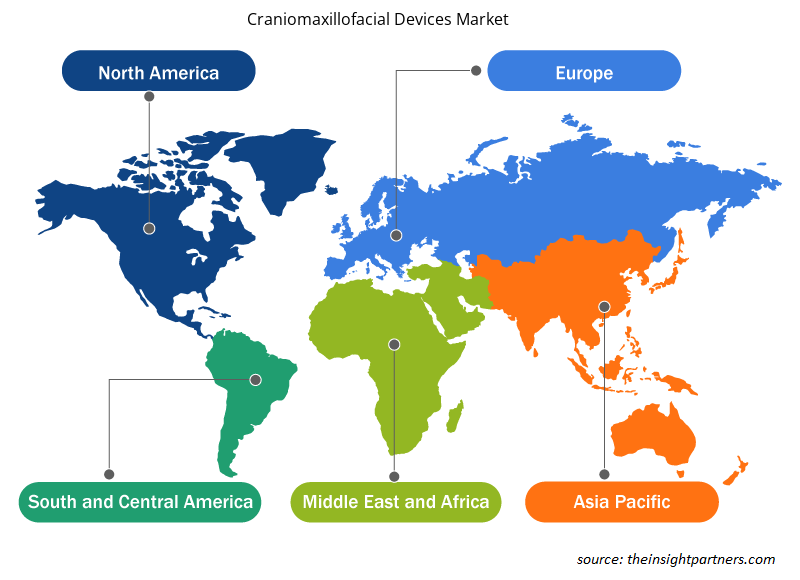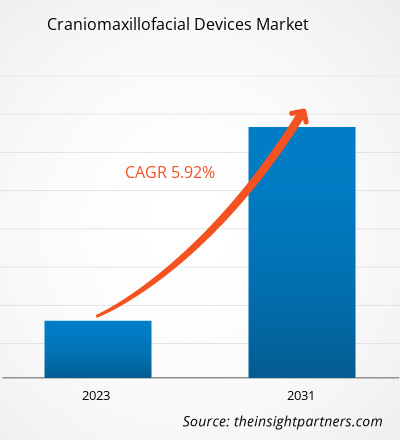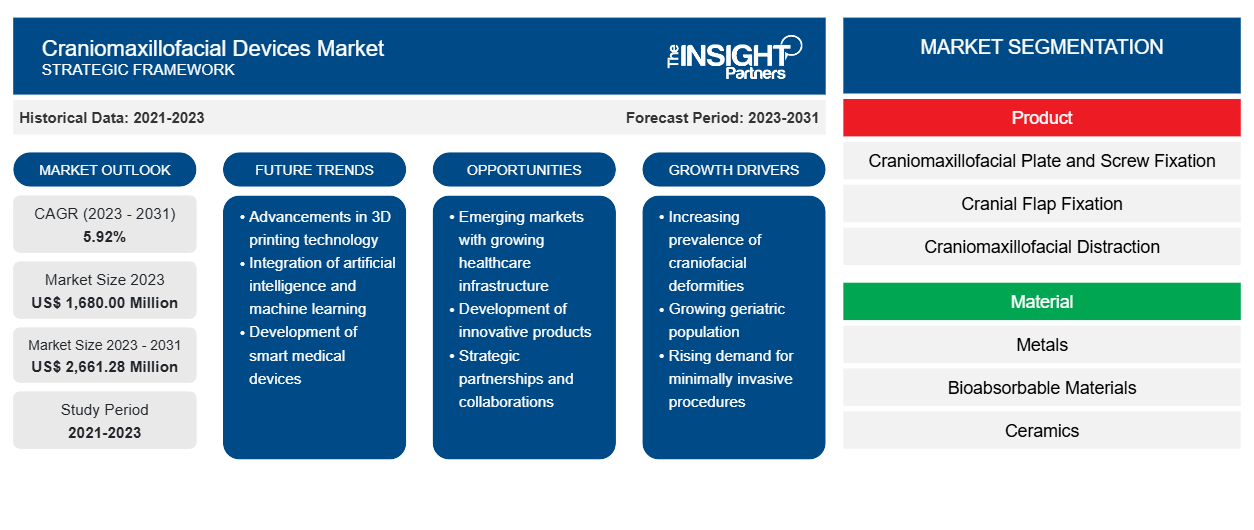[Informe de investigación] Se proyecta que el valor de mercado de los dispositivos craneomaxilofaciales crecerá de US$ 1.680,00 millones en 2023 a US$ 2.661,28 millones en 2031 a una CAGR del 5,92% entre 2023 y 2031.
Perspectivas del mercado y opinión de analistas:
Los dispositivos craneomaxilofaciales son equipos especializados, que incluyen instrumentos quirúrgicos, placas, tornillos e implantes, diseñados para procedimientos de tratamiento facial, craneal y mandibular. Estos dispositivos son vitales para tratar enfermedades, discapacidades congénitas, lesiones relacionadas con traumatismos, deformidades y anomalías. Los dispositivos craneomaxilofaciales se fabrican para adaptarse a las estructuras anatómicas únicas del cráneo y la cara. Están diseñados para garantizar la precisión quirúrgica, enderezar los rasgos faciales y ayudar a curar los huesos rotos. Además, estos dispositivos ayudan a reconstruir los huesos faciales, estabilizar las fracturas y mejorar los aspectos funcionales y la estética de las partes del cuerpo afectadas.
Los factores clave que impulsan el crecimiento del mercado de dispositivos craneomaxilofaciales incluyen la creciente demanda de procedimientos mínimamente invasivos, los avances en las tecnologías de impresión 3D e imágenes y un aumento mundial en el número de casos de lesiones graves y fracturas faciales. Los avances en las tecnologías de impresión 3D e imágenes permiten a los fabricantes ofrecer soluciones personalizadas a los clientes. Además de los avances tecnológicos y las soluciones personalizadas, los mejores resultados para los pacientes impulsan el mercado de dispositivos craneomaxilofaciales. Las tendencias del mercado de dispositivos craneomaxilofaciales incluyen implantes fabricados con materiales bioreabsorbibles para minimizar los problemas a largo plazo.
Factores impulsores del crecimiento y desafíos:
Se prevé que la necesidad de procedimientos quirúrgicos reconstructivos eficientes y el aumento del número de accidentes de tráfico provocados por la urbanización y la industrialización impulsen el mercado de dispositivos craneomaxilofaciales. Por ejemplo, varias causas de fracturas mandibulares incluyen agresiones, lesiones deportivas y accidentes automovilísticos, como se indica en el artículo "Prevalencia y patrón de fracturas mandibulares: un estudio retrospectivo en la India", publicado en 2022. Las técnicas mínimamente invasivas han revolucionado el campo de la cirugía craneomaxilofacial, ofreciendo a los pacientes beneficios como menos cicatrices, tiempos de recuperación más cortos y menor riesgo de complicaciones en comparación con las cirugías abiertas tradicionales. La creciente adopción de procedimientos mínimamente invasivos desencadena la demanda de dispositivos especializados diseñados para estos enfoques. Los dispositivos craneomaxilofaciales, como distractores, placas, tornillos e implantes, se están innovando para satisfacer los requisitos únicos de las cirugías mínimamente invasivas, lo que permite a los cirujanos realizar procedimientos intrincados con precisión y eficiencia. Además, los avances en la tecnología de impresión 3D permiten disponer de una gran cantidad de implantes eficaces, específicos para cada paciente y con una gran precisión. A medida que más profesionales sanitarios reconocen las ventajas de los procedimientos mínimamente invasivos en términos de mejores resultados y satisfacción de los pacientes, se espera que la demanda de dispositivos craneomaxilofaciales innovadores diseñados a medida para estas técnicas siga aumentando en los próximos años.
La disponibilidad limitada de profesionales capacitados que dominen las técnicas quirúrgicas avanzadas obstaculiza el crecimiento y el desarrollo del mercado, ya que los proveedores de atención médica tienen dificultades para satisfacer la creciente demanda de procedimientos complejos. Es probable que compensar esta brecha entre la demanda y la oferta mediante programas de capacitación e iniciativas educativas sea crucial para liberar todo el potencial del mercado de dispositivos craneomaxilofaciales y mejorar los resultados de los pacientes.
Personalice este informe según sus necesidades
Obtendrá personalización en cualquier informe, sin cargo, incluidas partes de este informe o análisis a nivel de país, paquete de datos de Excel, así como también grandes ofertas y descuentos para empresas emergentes y universidades.
- Obtenga las principales tendencias clave del mercado de este informe.Esta muestra GRATUITA incluirá análisis de datos, desde tendencias del mercado hasta estimaciones y pronósticos.
Segmentación y alcance del informe:
El análisis del mercado de dispositivos craneomaxilofaciales se ha llevado a cabo considerando los siguientes segmentos: producto, material y aplicación. Según la geografía, el mercado está segmentado en América del Norte (EE. UU., Canadá y México), Europa (Reino Unido, Alemania, Francia, Italia, España y resto de Europa), Asia Pacífico (China, Japón, India, Australia, Corea del Sur y resto de Asia Pacífico), Oriente Medio y África (EAU, Arabia Saudita, Sudáfrica y resto de Oriente Medio y África) y América del Sur y Central (Brasil, Argentina y resto de América del Sur y Central).
Análisis segmental:
Perspectivas basadas en productos
Según el producto, el mercado está segmentado en fijación de placa y tornillo craneomaxilofacial, fijación de colgajo craneal, distracción craneomaxilofacial, reemplazo de articulación temporomandibular, fijación torácica y sustituto de injerto óseo . El segmento de fijación de placa y tornillo craneomaxilofacial tuvo la mayor participación de mercado de dispositivos craneomaxilofaciales en 2023. Se prevé que registre la CAGR más alta de 2023 a 2031.
Perspectivas basadas en materiales
Según el material, el mercado de dispositivos craneomaxilofaciales se segmenta en metales, materiales bioabsorbibles y cerámicas. Se prevé que el segmento de metales tenga una participación significativa en 2031.
Perspectivas basadas en aplicaciones
Según la aplicación, el mercado se divide en neurocirugía y otorrinolaringología, cirugía ortognática y dental, y cirugía plástica. Se prevé que el segmento de cirugía ortognática y dental ocupe una participación significativa en 2031.
Perspectivas regionales del mercado de dispositivos craneomaxilofaciales
Los analistas de Insight Partners explicaron en detalle las tendencias y los factores regionales que influyen en el mercado de dispositivos craneomaxilofaciales durante el período de pronóstico. Esta sección también analiza los segmentos y la geografía del mercado de dispositivos craneomaxilofaciales en América del Norte, Europa, Asia Pacífico, Medio Oriente y África, y América del Sur y Central.

- Obtenga datos regionales específicos para el mercado de dispositivos craneomaxilofaciales
Alcance del informe de mercado de dispositivos craneomaxilofaciales
| Atributo del informe | Detalles |
|---|---|
| Tamaño del mercado en 2023 | US$ 1.680,00 millones |
| Tamaño del mercado en 2031 | US$ 2.661,28 millones |
| CAGR global (2023 - 2031) | 5,92% |
| Datos históricos | 2021-2023 |
| Período de pronóstico | 2023-2031 |
| Segmentos cubiertos | Por producto
|
| Regiones y países cubiertos | América del norte
|
| Líderes del mercado y perfiles de empresas clave |
|
Densidad de actores del mercado de dispositivos craneomaxilofaciales: comprensión de su impacto en la dinámica empresarial
El mercado de dispositivos craneomaxilofaciales está creciendo rápidamente, impulsado por la creciente demanda de los usuarios finales debido a factores como la evolución de las preferencias de los consumidores, los avances tecnológicos y una mayor conciencia de los beneficios del producto. A medida que aumenta la demanda, las empresas amplían sus ofertas, innovan para satisfacer las necesidades de los consumidores y aprovechan las tendencias emergentes, lo que impulsa aún más el crecimiento del mercado.
La densidad de actores del mercado se refiere a la distribución de las empresas o firmas que operan dentro de un mercado o industria en particular. Indica cuántos competidores (actores del mercado) están presentes en un espacio de mercado determinado en relación con su tamaño o valor total de mercado.
Las principales empresas que operan en el mercado de dispositivos craneomaxilofaciales son:
- DePuy Synthes (J&J)
- Stryker, Medtronic
- B. Braun Melsungen AG
- Compañía: Reni Shaw plc.
- Medartis AG
Descargo de responsabilidad : Las empresas enumeradas anteriormente no están clasificadas en ningún orden particular.

- Obtenga una descripción general de los principales actores clave del mercado de dispositivos craneomaxilofaciales
Análisis regional:
El alcance geográfico del informe de mercado de dispositivos craneomaxilofaciales abarca América del Norte, Europa, Asia Pacífico, Oriente Medio y África, y América del Sur y Central. América del Norte tuvo la mayor participación del mercado en 2023 y se prevé que mantenga su dominio (en términos de participación) durante el período de pronóstico. Estados Unidos tiene la mayor participación del mercado norteamericano y mundial. El crecimiento del mercado en este país se atribuye a una gran participación en los deportes, un aumento en el número de casos de fracturas faciales y una gran cantidad de atletas internacionales que residen en el país. Además, es probable que la creciente demanda de procedimientos mínimamente invasivos beneficie al mercado de este país.
Debido a su sistema de salud altamente desarrollado, Estados Unidos ha llamado la atención de grandes corporaciones globales que buscan aumentar su participación en el mercado. Además, el número de cirugías que se realizan en Estados Unidos aumenta cada año, lo que beneficia al mercado en estudio. La Academia Estadounidense de Cirujanos Craneomaxilofaciales analiza los últimos avances y los detalles de la investigación en cirugía craneomaxilofacial. Durante la reunión anual de 2021 se analizó el futuro de la neurocirugía fetal intrauterina y otros métodos quirúrgicos.
Panorama competitivo y empresas clave:
El pronóstico del mercado de dispositivos craneomaxilofaciales presentado en este informe puede ayudar a las partes interesadas en este mercado a planificar sus estrategias de crecimiento. DePuy Synthes (J&J), Stryker, Medtronic, B. Braun Melsungen AG, Reni Shaw plc., Medartis AG, KLS Martin Group, Xilloc Medical B. V, Synimed y Zimmer-Biomet son algunas de las empresas clave que se describen en el informe del mercado de dispositivos craneomaxilofaciales. Estas empresas se centran en ampliar sus ofertas para satisfacer la creciente demanda de los consumidores en todo el mundo. Su presencia global les permite atender a muchos clientes, lo que les permite posteriormente ampliar su presencia en el mercado.
- Análisis histórico (2 años), año base, pronóstico (7 años) con CAGR
- Análisis PEST y FODA
- Tamaño del mercado, valor/volumen: global, regional y nacional
- Industria y panorama competitivo
- Conjunto de datos de Excel
Informes recientes
Informes relacionados
Testimonios
Razón para comprar
- Toma de decisiones informada
- Comprensión de la dinámica del mercado
- Análisis competitivo
- Información sobre clientes
- Pronósticos del mercado
- Mitigación de riesgos
- Planificación estratégica
- Justificación de la inversión
- Identificación de mercados emergentes
- Mejora de las estrategias de marketing
- Impulso de la eficiencia operativa
- Alineación con las tendencias regulatorias





















 Obtenga una muestra gratuita para - Mercado de dispositivos craneomaxilofaciales
Obtenga una muestra gratuita para - Mercado de dispositivos craneomaxilofaciales